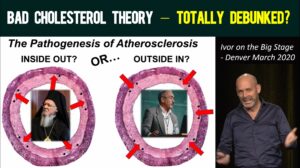Ivor Cummins 00:24 I’m here in Bergün, Switzerland at the Keto Live conference and I’ve caught up again with Dr. John Schoonbee.
John Schoonbee 00:31 Hi, Ivor.
Ivor 00:32 And you are Medical Director for Swiss Re, which is the first or possibly second biggest Reinsurance organization worldwide.
John 00:41 That’s right. I’m the Chief Medical Officer for the Life and Health Division of Swiss Re.
Ivor 00:47 Right – so you have a huge incentive, you and all your teams and your organization in very accurately getting life expectancy for high value clients?
John 00:56 Yep, absolutely. So our biggest liability is in life insurance. So it relies on the longevity of the applicants that we reinsure. And by far the biggest risk that we have is that people who are more unhealthy [than we expect], and live shorter than we expect them to.
Ivor 01:16 Right. And then you described to me, actually, surprisingly high-value clients for… I mean, what are the higher-level sums that people insured themselves for?
John 01:26 Quite shocking numbers actually. We see cases between 50 and 100 million dollars, not infrequently.
Ivor 01:33 Okay. So if you add those up, and then the 10 million ones and all that, it adds up to a huge sum.
John 01:39 It’s big. It’s very, very big.
Ivor 01:40 And then you described as well in your talk, I really enjoyed your talk, but you described to a lot of people get lumped into one broad category of risk, but then higher risk people get separated out, but they’re particularly high risk usually.
John 01:54 Yeah. The principle of the insurance really is that you pull groups of people together with similar risk and you charge them a similar premium.
Ivor 02:04 Right. Exactly. So one of the things I really want to talk to you about was coronary artery calcification. And we’re just chatting this morning about the 2018 AHA/ACC guidelines that come out. And very big development that the new guidelines of coronary artery calcification with a Level II-A evidence rating, which is really high actually, and as a new direction being set to use coronary calcification for middle risk people to help with, you know, medication decisions. If you’re a low score, you have low disease, maybe you don’t need a drug that your middle risk would have suggested. But I think for you, you’re particularly interested in calcification these days because of really getting a good assessment of risk for people.
John 02:47 Yeah. Yeah, so we do something called underwriting people when they apply for life cover. And as you mentioned, the highest sums assured, and the people with higher risk. So it would be males, slightly older males, people who smoke, people who are diabetic. We want to make sure that these people don’t have coronary artery disease.
03:06 So traditionally, the industry is slow moving. It’s a conservative industry. And traditionally we’ve used stress tests, we exercise ECGs to try and assess whether these people have coronary artery disease. And one of the big problems with stress test is that the specificity and sensitivity is very low. So we see a lot of these ECGs, that, of course, it’s the electrical activity that the heart shows. And when it’s under stress, you see changes in this electrical activity, but you only see these changes in about two thirds of people with actual obstructive coronary artery disease. So we’re talking about 60, 70% obstruction, then you only pick it up, maybe 60 or 70% of the time. And then of course, you get a bunch of false positives. So you get people that look like, “Oh, my gosh,” and they, you know, we’re not happy to offer them insurance, and then they go off and they get angiogram done, and there’s no disease. So the test is not a great test. But it’s a test we’ve been using.
04:14 One of the things that we’re looking at is to replace that test [Inaudible 00:04:19] calcium, because of course, you’re not just looking at, don’t call end stage disease, but advanced coronary artery disease. You’re looking at the full spectrum. So that’s the first benefit is that you’re not just catching the late stage disease, you’re catching middle stage and early disease as well. And of course, when you catch it early and middle stage, not only do we as an organization, then know that this person actually has coronary artery disease, whereas we may have thought they didn’t if we only had done the stress test. But that person can then get the appropriate treatment to address the risk factor. So it’s good for them, it’s good for us. And it just makes a whole lot more sense. And of course, you don’t get false positives on a calcium score. The calcium’s there in the coronary arteries. The person has CAD.
Ivor 05:14 Exactly. And a super high score is 20 times the risk of an event of a zero score, regardless of your age. So it speaks to the power.
05:32 But yeah, I must say that resonates with me, because the stress test actually, when you look through the data is very poor, as you describe. It’s better than nothing but quite poor. And David Bobbett, actually my sponsor of Irish Heart Disease Awareness, he’s a typical example. He aced the stress tests, top 10% of fitness for his age, yet his CAC was a 1,000 score and he had three blocked arteries. So yeah.
05:54 The other thing is the power of zero then which came out as a campaign in the last few years and culminated possibly in helping the 2018 guidelines and training calcification. But the zero-scoring people you get then, you know they’re really low risk
John 06:11 Yes. And of course, what we can then do is, if somebody has a certain risk factor that we possibly worry about related to coronary artery disease, but we then see that… so underwriting and assessing risk is not a perfect science. Of course, there are calculators, cure risk score, cure risk history, whatever, that one can use, we have our own internal guidelines, but they’re not absolute. And so often, particularly these “high sum-assured” cases get referred to doctors, who work for Swiss Re. And they then have to decide where that risk is. And of course, we give debits and credits, depending on what we find. Certainly in terms of metabolic disease, things like triglycerides, HDL, play a big role. And a calcium score of zero would play a huge role. Absolutely – a huge role for me.
Ivor 07:03 Right. But currently the calcium score, like in a lot of the other industries and even the guidelines to a point, currently, it’s really used very little. I mean, you have specific insight into the CAC score which we’re discussing, but your colleagues and people across the business currently…
John 07:21 No. No, it’s not a widespread test… there’s very little widespread use and it’s certainly something we’re trying to expand. But as I say, it’s hard to move a big ship. But I think a lot of people are beginning to realize that there is value. And every now and then we do get, particularly the “high sum-assured people”, taking up big covers would have gone to a cardiologist who kind of would have seen the light and would have done a calcium score. And then we get the calcium score which is great, but currently, it’s not a requirement. So it’s not something we asked somebody to do. Although my aim is to try and change that.
Ivor 08:00 Excellent. And just to that point about the… you mentioned to me that sometimes you actually asked for an angiogram in very high risk lines. Interestingly, the approximate statistics is if you have a zero calcium score, you’re around 99% assured of not having [Inaudible 00:08:15] greater than 50 or 70%. So incredible accuracy there.
08:21 You are going to be part of this new movement to get calcification adopted across the world both to save people, as you say and get them the right treatment, but also from a business sense to get much better business accuracy in assessing, you know, what kinds of premium should be charged?
John 08:38 Absolutely!
Ivor 08:39 Great job, John. Thanks a lot!
John 08:40 Thanks, Ivor. Cheers!








